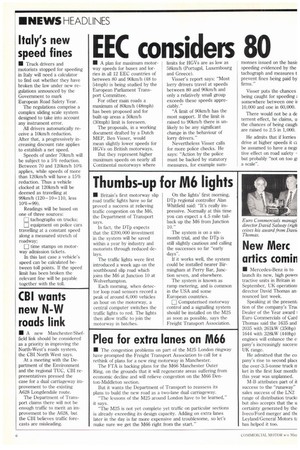EEC considers 80
Page 6

If you've noticed an error in this article please click here to report it so we can fix it.
• A plan for maximum motorway speeds for buses and lorries in all 12 EEC countries of between 80 and 90km/h (48 to 54mph) is being studied by the European Parliament Transport Committee.
For other main roads a maximum of 80km/h (48mph) has been proposed and for built-up areas a 50Iun/h (30mph) limit is foreseen.
The proposals, in a working document drafted by a Dutch MEP, Ben Visser, would mean slightly lower speeds for HGVs on British motorways.
But they represent higher maximum speeds on nearly all Continental motorways where limits for HGVs are as low as 58km/h (Portugal, Luxembourg and Greece).
Visser's report says: Most lorry drivers travel at speeds between 80 and 90km/h and only a relatively small group exceeds these speeds appreciably."
"A limit of 90km/h has the most support. If the limit is raised to 90km/h there is unlikely to be any significant change in the behaviour of lorry drivers."
Nevertheless Visser calls for more police checks. He says: "Action by the police must be backed by statutory measures, for example sum
monses issued on the basis speeding evidenced by the tachograph and measures t prevent fines being paid by firms."
Visser puts the chances being caught for speeding somewhere between one ii 10,000 and one in 60,000.
There would not be a d€ terrent effect, he claims, u the chances of being caugh are raised to 2.5 in 1,000.
He admits that if lorries drive at higher speeds it ci be assumed to have a new tive effect on road safety but probably "not on too g a scale".




















































































